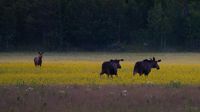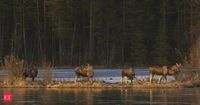In a world often filled with chaos and uncertainty, Sweden has found solace in an unexpected source: a livestream of moose migrations. Dubbed "The Great Moose Migration," this 24-hour event captivates millions, offering a tranquil escape from daily stresses.
The livestream, which began on April 15, 2025, is airing a week earlier than usual due to warmer weather, and will continue until May 4, 2025. Viewers can watch as dozens of moose migrate to their favorite pastures, located approximately 187 miles northwest of Stockholm. This annual phenomenon has become a national obsession since its inception in 2019, when nearly a million Swedes tuned in to watch moose traverse forests and swim across the Ångerman River.
By 2024, the production had drawn an astonishing 9 million viewers on SVT Play, Sweden's national public television streaming platform. The appeal of the livestream lies in its simplicity; there’s no narration or music, just the serene sounds of nature as the moose go about their daily activities.
Ulla Malmgren, a dedicated viewer, shared her preparations for the event, stating, "Sleep? Forget it. I don’t sleep." Her enthusiasm is echoed by many who have turned the migration into a daily ritual, with over 78,000 Swedes joining a Facebook group dedicated to sharing their viewing experiences.
“It became, in a strange way, gripping, because nothing catastrophic is happening, nothing spectacular is happening,” said one fan. “But something very beautiful is happening.” This sentiment captures the essence of slow TV, a genre that has gained traction since Norway's public broadcaster NRK aired a seven-hour train journey in 2009. The format has since spread globally, with similar productions in the UK, China, and even the U.S.
Annette Hill, a professor of media and communications at Jönköping University, noted that slow TV allows viewers to engage with nature in a way that feels authentic and unfiltered. “This is definitely a moment to have a calm, atmospheric setting in my own home, and I really appreciate it,” she said. Hill believes that the livestream helps viewers slow down and appreciate the natural rhythms of spring.
The production team, working from SVT’s control room in Umeå, employs around 20,000 meters (almost 12 miles) of cable, 26 remote cameras, and seven night cameras to capture the migration. A drone is also utilized to provide aerial views of the moose as they make their way across the landscape. Johan Erhag, SVT's project manager for the event, explained that the crew maintains a respectful distance to avoid disturbing the animals, which have followed the same migratory routes for thousands of years.
Despite their size—bull moose can reach heights of 210 centimeters (6 feet 10 inches) and weigh up to 450 kilograms (992 pounds)—these majestic creatures are often elusive. With approximately 300,000 moose roaming Sweden, the livestream offers a rare opportunity for viewers to observe them in their natural habitat.
Fans eagerly anticipate moments when a moose appears on screen, often sharing their excitement in real-time through social media. “I would actually like to be a little fly on the wall in every household that watches the moose migration,” Malmgren remarked. “Because I think there are about a million people saying the same thing: ‘Go on! Yes, you can do it!’”
The livestream not only provides entertainment but also serves as a therapeutic escape for many viewers. The calming effect of watching moose meander through their environment helps reduce stress for both the audience and the production team. Erhag noted, “Everyone who works with it goes down in their normal stress.”
The migration has become a cultural touchstone in Sweden, symbolizing a connection to nature and a collective appreciation for the beauty of the animal kingdom. As viewers tune in day after day, they find joy in the mundane moments, watching the wildlife as it interacts with the landscape.
For many, the experience transcends mere observation; it's a way to engage with the rhythms of nature while finding comfort in the shared experience with others. “You can watch them and be a part of their natural habitat in a way that you could never be otherwise,” said one fan who began watching in 2019.
As the livestream continues to capture the hearts of viewers, it stands as a testament to the power of nature to bring people together, even in a digital age. The Great Moose Migration has become more than just a show; it’s a phenomenon that fosters community, relaxation, and a deeper appreciation for the natural world.
As the cameras roll and the moose make their way to summer pastures, viewers worldwide are reminded of the beauty that exists just outside their windows, waiting to be discovered. With the livestream running until May 4, there’s still plenty of time to tune in and witness the majesty of the moose migration.





